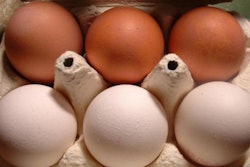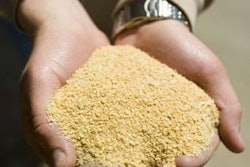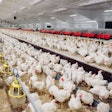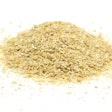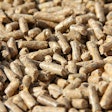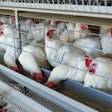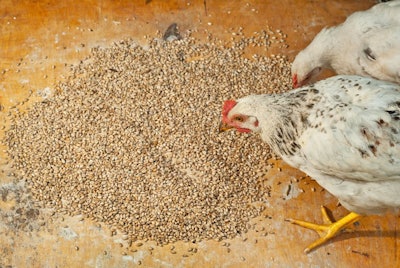
In redesigning modern layer feeds, removing wheat flour byproducts can have advantages.
I have been recently involved in examining and redesigning layer feeds with the aim of bringing them into this century. One of the items I have been adamant about is removing wheat bran or any other wheat flour byproduct, such as middlings. Here is my reasoning.
Mycotoxins
In my personal experience, perhaps because as a consultant I am consulted mostly when there is a problem, wheat bran is high on the suspect list of mycotoxin contaminated feedstuffs. This is because, in order to produce wheat flour for human consumption, all outer layers of the wheat seed (or kernel) are removed, and that is where mycotoxins reside. Fortunately, most are removed by washing the seeds before processing, but I have encountered many batches of wheat bran that contain mycotoxins.
Non-starch polysaccharides
These fiber components, especially the hemicelluloses, are concentrated in the pericarp (outer shell) from which bran and middlings come. Enzymes to counter these undesirable fibers exist, but they increase feed cost and do not always work as efficiently as it is required. Hemicelluloses tend to reduce overall nutrient digestibility and, because they form a gel-like substance, they can be the source of dirty eggs and wet droppings.
Cost
Wheat bran used to be the inexpensive ingredient that could replace a good part of cereals. But, due to high demand from feedlot cattle feed manufacturers, they are now too costly to be used in feeds for animals that enjoy flimsy margins of profitability. In some cases, they are even unavailable in bulk and have to be bought in large bags, something that not only further increases cost but it perplexes feed manufacturing. So, by removing them, one simplifies the process of mixing feed.
Bulkiness
Older genetics used to eat more. They had a greater body weight and, hence, a much better appetite. The trend today is for small-sized hens (to reduce maintenance needs) that produce larger eggs for longer. As a result, feed intake is always a problem – first, because appetite is reduced, and secondly because large eggs require more feed, and producers are not always willing to pay for a more concentrated feed (in terms of nutrients and energy). Thus, adding wheat bran that absorbs water and increasing gut fill and the feeling of satiety only reduces the intake of useful nutrients.
Having said all that, I must declare that I have nothing against wheat bran, and if the price and quality is right, I use them in certain feeds in almost all species that I work with. But, the above discussion is just a general take of my opinion for this feed as it applies to modern animal feed manufacturing for modern genetics.


